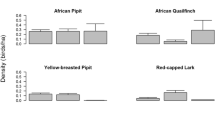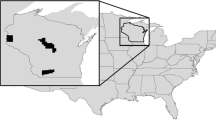Abstract
Populations of many grassland bird species such as Grasshopper Sparrow (Ammodramus savannarum), Henslow’s Sparrow (A. henslowii), and Bobolink (Dolichonyx oryzivorus) have experienced considerable declines over the last century. To foster multi-species grassland bird conservation in the Upper Great Lakes (UGL) states of Michigan, Minnesota, and Wisconsin, we quantified geographic patterns within three sub-regional zones (e.g., North, Central, and South) of the UGL. Patterns of interest included the distribution and abundance of openland cover type (including managed pasture-hayland), the distribution, phenology, habitat affinity, and long-term population trends of ten grassland bird species, and (in particular) the geographic patterns in hayfield mowing and the temporal changes in hayfield cover. Approximately 10, 38, and 53% of the UGL openland was proportioned in the North, Central, and South zones, respectively. The distribution of hayland also varied by zone: North, 17%; Central, 46%; and South, 37%. In the central portion of the UGL where the greatest area is devoted to hay production, alfalfa—more intensively managed than mixed-grass hay—predominates. Although we found significance differences (P < 0.05) in hayfield mowing intensity between zones (with the majority of land under relatively low-intensity mowing found in the North Zone, particularly the Upper Peninsula of Michigan) no strong relationships were found between hayfield mowing patterns, other land cover-land use variables, and bird population trends at finer scales of study. Nonetheless, we suggest that the geographic patterns illustrated here provide useful information for grassland bird conservation planning across the UGL.






Similar content being viewed by others
References
Askins RA (2000) Restoring North America’s birds. Yale University Press, New Haven
Askins RA, Chavez-Ramirez F, Dale RC et al (2007) Conservation of grassland birds in North America: understanding ecological processes in different regions. Ornithol Monogr 64:1–46
Bachand RR (2001) The American prairie: going, going, gone? National Wildlife Federation, Boulder
Barger NR, Robbins SD Jr, Temple SA (1988) Wisconsin birds. The Wisconsin Society for Ornithology, Hartland
Best LB, Campa HIII, Kemp KE et al (1997) Bird abundance and nesting in CRP fields and cropland in the Midwest: a regional approach. Wildl Soc Bull 25:864–877
Bollinger EK (1995) Successional change and habitat selection in hayfield bird communities. Auk 112:720–730
Bollinger EK, Gavin TA (1992) Eastern bobolink populations: ecology and conservation in an agricultural landscape. In: Hagan JM III, Johnston DW (eds) Ecology and conservation of neotropical migrant landbirds. Smithsonian Institution Press, Washington DC, pp 497–506
Bollinger EK, Bollinger PB, Gavin TA (1990) Effects of hay-cropping on eastern populations of the bobolink. Wildl Soc Bull 18:142–150
Brewer R, McPeek GA, Adams RA Jr (1991) The atlas of breeding birds of Michigan. Michigan State University Press, East Lansing
Broyer J (2003) Unmown refuge areas and their influence on the survival of grassland birds in the Saone valley (France). Biodivers Conserv 12:1219–1237. doi:10.1023/A:1023099901308
Carter FC, Hunter WC, Pashley DN et al (2000) Setting conservation priorities for landbirds in the United States: the partners in flight approach. Auk 117:541–548. doi:10.1642/0004-8038(2000)117[0541:SCPFLI]2.0.CO;2
Corace RG III (2007) Using multiple spatial scales to prioritize openland bird conservation in the Midwest. Doctoral Dissertation, Michigan Technological University
Corace RG III, Goebel PC, Wyse TC (2005) A landscape to field-scale assessment of the bird communities of historic openlands at Sleeping Bear Dunes National Lakeshore. Mich Birds Nat Hist 12:169–181
Daily GC, Ehrlich PR, Sanchez-Azofeifa GA (2001) Countryside biogeography: use of human-dominated habitats by the avifauna of southern Costa Rica. Ecol Appl 11:1–13. doi:10.1890/1051-0761(2001)011[0001:CBUOHD]2.0.CO;2
Dechant JA, Sondreal ML, Johnson DH et al (1999) Effects of management practices on grassland birds. Northern Prairie Wildlife Research Center, Jamestown
Ehrlich PR, Dobkin DS, Wheye D (1988) The birder’s handbook. Simon and Schuster, Inc., New York
Fletcher RJ Jr, Koford RR (2002) Habitat and landscape associations of breeding birds in native and restored grasslands. J Wildl Manag 66:1011–1022. doi:10.2307/3802933
Herkert JR (1997) Bobolink Dolichonyx oryzivorus population decline in agricultural landscapes in the Midwestern USA. Biol Conserv 80:107–112. doi:10.1016/S0006-3207(96)00066-3
Herkert JR, Sample DW, Warner RE (1996) Management of midwestern grassland landscapes for the conservation of migratory birds. In: Thompson FR III (ed) Management of midwestern landscapes for the conservation of neotropical migratory birds. U.S. Forest Service, St. Paul
Hitch A, Leberg PL (2007) Breeding distributions of North American bird species moving north as a result of climate change. Conserv Biol 21:534–539. doi:10.1111/j.1523-1739.2006.00609.x
Horn DJ, Koford RR (2000) Relation of grassland bird abundance to mowing of conservation reserve program fields in North Dakota. Wildl Soc Bull 28:653–659
Janssen RB (1987) Birds in Minnesota. University of Minnesota Press, Minneapolis
Knopf FL (1996) Prairie legacies: birds. In: Samson FB, Knopf FL (eds) Prairie conservation. Island Press, Washington DC, pp 135–148
Koford RR, Best LB (1996) Management of agricultural landscapes for conservation of neotropical migratory birds. In: Thompson FR III (ed) Management of midwestern landscapes for the conservation of neotropical migratory birds. U.S. Forest Service, St. Paul
Marshall SA, Campbell CP, Buchanan-Smith JG (1998) Seasonal changes in quality and botanical composition of a rotationally grazed grass-legume pasture in southern Ontario. Can J Anim Sci 78:205–210
Maurer BA (1986) Predicting habitat quality for grassland birds using density-habitat correlations. J Wildl Manag 50:556–566. doi:10.2307/3800963
McCoy TD, Ryan MR, Kurzejeski EW et al (1999) Conservation reserve program: source or sink habitat for grassland birds in Missouri. J Wildl Manag 63:530–538. doi:10.2307/3802639
McCoy TD, Kurzejeski EW, Burger LW Jr et al (2001) Effects of conservation practice, mowing, and temporal changes on vegetation structure on CRP fields in northern Missouri. Wildl Soc Bull 29:979–987
McNab WH, Avers PE (1994) Ecological subregions of the United States: section descriptions. U.S. Forest Service, Washington DC
Millenbah KF, Winterstein SR, Campa H III et al (1996) Effects of conservation reserve program field age on avian relative abundance, diversity, and productivity. Wilson Bull 108:760–770
Murphy MT (2003) Avian population trends within the evolving agricultural landscape of eastern and central United States. Auk 120:20–34. doi:10.1642/0004-8038(2003)120[0020:APTWTE]2.0.CO;2
National Land Cover Data (NLCD) (1992) Multi-resolution land characteristics consortium, Sioux Falls, South Dakota. http://landcover.usgs.gov. Accessed May 2007
O’Connor RJ, Jones MT, Boone RB et al (1999) Linking continental climate, land use, and land patterns with grassland bird distribution across the conterminous United States. Stud Avian Biol 19:45–59
Pearson RA, Archibald RF, Muirhead RH (2006) A comparison of the effect of forage type and level of feeding on the digestibility and gastrointestinal mean retention time of dry forages given to cattle, sheep, ponies and donkeys. Br J Nutr 95:88–98. doi:10.1079/BJN20051617
Perlut NG, Strong AM, Donovan TM et al (2006) Grassland songbirds in a dynamic management landscape: behavioral responses and management strategies. Ecol Appl 16:2235–2247. doi:10.1890/1051-0761(2006)016[2235:GSIADM]2.0.CO;2
Peterjohn BG (2003) Agricultural landscapes: can they support healthy bird populations as well as farm products? Auk 120:14–19. doi:10.1642/0004-8038(2003)120[0014:ALCTSH]2.0.CO;2
Ribic CA, Sample DW (2001) Associations of grassland birds with landscape factors in southern Wisconsin. Am Midl Nat 146:105–121. doi:10.1674/0003-0031(2001)146[0105:AOGBWL]2.0.CO;2
Sample DW, Mossman MJ (1997) Managing habitat for grassland birds: a guide for Wisconsin. Wisconsin Department of Natural Resources, Madison
Samson F, Knopf F (1994) Prairie conservation in North America. Bioscience 44:418–421. doi:10.2307/1312365
Sanderson EW, Jaiteh M, Levy MA et al (2002) The human footprint and the last of the wild. Bioscience 52:891–904. doi:10.1641/0006-3568(2002)052[0891:THFATL]2.0.CO;2
Sauer JR, Hines JE, Fallon J (2007) The North American breeding bird survey, results and analysis 1966–2006. Version 10.13.2007. U. S. geological survey. Patuxent Wildlife Research Center, Laurel
Soderstrom B, Part T (2000) Influence of landscape scale on farmland birds breeding in semi-natural pastures. Conserv Biol 14:522–533. doi:10.1046/j.1523-1739.2000.98564.x
Thompson FR III, Lewis SJ, Green J (1993) Status of neotropical migrant landbirds in the Midwest: identifying species of management concern. In: Finch DM, Stangle PW et al (eds) Management of midwestern landscapes for the conservation of neotropical migratory birds. U.S. Forest Service, St. Paul, pp 145–158
Troy AR, Strong AM, Bosworth SC, Donovan Tm, Buckley NJ, Wilson ML (2005) Attitudes of Vermont dairy farmers regarding adoption of management practices for grassland birds. Wildl Soc Bull 33:528–538. doi:10.2193/0091-7648(2005)33[528:AOVDFR]2.0.CO;2
USDA (1997) Census of agriculture, 1997. U.S. Department of Agriculture, National Agricultural Statistics Service, Washington DC
USDA (2000) Census of agriculture, 2000. U.S. Department of Agriculture, National Agricultural Statistics Service, Washington DC
Van Horne B (1983) Density as a misleading indicator of habitat quality. J Wildl Manag 47:893–901. doi:10.2307/3808148
Verch D (1999) Chequamegon Bay Birds. Northland College, Ashland
Vickery PD, Hunter ML Jr, Wells JV (1992) Is density an indicator of breeding success? Auk 109:706–710
Vickery PD, Hunter ML Jr, Melvin SM (1994) Effects of habitat area on the distribution of grassland birds in Maine. Conserv Biol 8:1087–1097. doi:10.1046/j.1523-1739.1994.08041087.x
Warner RE (1994) Agricultural land use and grassland habitat in Illinois: future shock for Midwestern birds? Conserv Biol 8:147–156. doi:10.1046/j.1523-1739.1994.08010147.x
Wolff A, Paul JP, Martin JL et al (2001) The benefits of extensive agriculture to birds: the case of the little bustard. J Appl Ecol 38:963–975. doi:10.1046/j.1365-2664.2001.00651.x
Wolter PT, Johnston CA, Niemi GJ (2006) Land use land cover change in the U.S. Great Lakes Basin 1992 to 2001. J Great Lakes Res 32:607–628. doi:10.3394/0380-1330(2006)32[607:LULCCI]2.0.CO;2
Zar JH (1999) Biostatistical analysis, 4th edn. Prentice Hall, Upper Saddle River
Acknowledgments
The authors wish to thank Seney Natural History Association for financial support and Seney National Wildlife Refuge for logistical support. Special thanks go out to all the resource professionals who provided data pertaining to hayfield mowing patterns and to Jennifer Papillo who assisted with collecting these data. Previous drafts of this manuscript were improved through the numerous comments and suggestions of John Probst. Other reviewers included Chris Burnett, Eric Gustafson, James Herkert, Rolf Koford, Damon McCormick, Holly Petrillo, Tom Will, and two anonymous reviewers. We thank all for their input.
Author information
Authors and Affiliations
Corresponding author
Rights and permissions
About this article
Cite this article
Corace, R.G., Flaspohler, D.J. & Shartell, L.M. Geographical patterns in openland cover and hayfield mowing in the Upper Great Lakes region: implications for grassland bird conservation. Landscape Ecol 24, 309–323 (2009). https://doi.org/10.1007/s10980-008-9306-8
Received:
Accepted:
Published:
Issue Date:
DOI: https://doi.org/10.1007/s10980-008-9306-8




